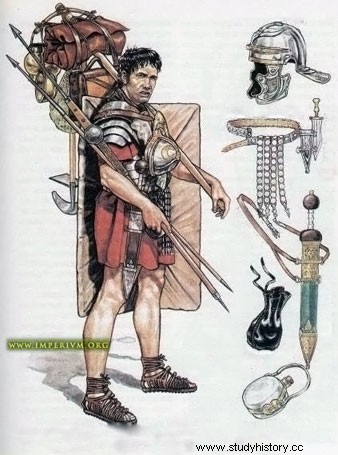On several occasions we have spoken of animals that shared sorrows and joys with the armies, either as pets or actively participating and, of course, never of their own free will. But this time we are going to deal not with the animals themselves but with the names of animals used in the glorious Roman legions:
Turtle (testudo ):is a formation of the legions. The legionnaires protect themselves with shields forming a shell that protects the advance against thrown weapons.

Turtle Formation
Eagle (aquila ):although previously there were several banners (eagle, wolf, boar...) with the reform of Cayo Mario in the II B.C. the eagle was adopted as the standard of all the legions.


Aquila
Deer (cervus ):defensive structure formed by a palisade to which thick branches with sharp points are added, like deer antlers.
Hedgehog (ericius ):defensive structure in which logs were buried to which metal hooks and spikes were attached, like hedgehogs, and covered with weeds.
Raven (corvus ):it was a weapon of the Roman navy intended for boarding. Of Greek origin, it was a kind of hook that was attached to enemy ships by sticking an iron spike into the deck to facilitate boarding.

Corvus
Wolf (lupus ):hook or iron spear used by the defenders of a wall to hook enemies trying to climb it to throw them or leave them hanging.
Wild ass or onager (onager ):it is a siege weapon of the catapult type, which had a torsion mechanism. The name onager is a reference to the Asian wild ass of the same name, which is known for its short temper and can kick a man some distance, just as this siege weapon used to throw stones at enemy walls.

Ram (aries ):battering ram.

Canero Ram
Scorpion (scorpio ):it was a shooting war machine, which owes its name to the scorpion-like pincers with which it grabbed the darts to launch them.

scorpio
Woodworm (terebra ):siege engine to pierce or break down walls.

Terebra
Butterfly (papilio ):large military tent from which the term flag derives .

Roman camp
Little mouse (musculus ):mobile shelter to prepare the ground before attacking with siege weapons.
Mario's Mules (muli Mariani ):this is how the legionnaires were called after the reform of Cayo Mario. In order not to depend on the supply columns, which hindered and delayed the march, the impedimenta of the legionnaires was increased, reaching a load of 30 kg.

Mario's Mules
Source:Cabinet of Roman Curiosities – J.C. McKeown Images:Raffaele Caruso, 1, 2,3, 4, 5, 6
